Related Research Articles

Etruscan was the language of the Etruscan civilization in the ancient region of Etruria, in Etruria Padana and Etruria Campana in what is now Italy. Etruscan influenced Latin but was eventually completely superseded by it. The Etruscans left around 13,000 inscriptions that have been found so far, only a small minority of which are of significant length; some bilingual inscriptions with texts also in Latin, Greek, or Phoenician; and a few dozen purported loanwords. Attested from 700 BC to AD 50, the relation of Etruscan to other languages has been a source of long-running speculation and study, with it mostly being referred to as one of the Tyrsenian languages, at times as an isolate, and a number of other less well-known hypotheses.

The Italic languages form a branch of the Indo-European language family, whose earliest known members were spoken on the Italian Peninsula in the first millennium BC. The most important of the ancient Italic languages was Latin, the official language of ancient Rome, which conquered the other Italic peoples before the common era. The other Italic languages became extinct in the first centuries AD as their speakers were assimilated into the Roman Empire and shifted to some form of Latin. Between the third and eighth centuries AD, Vulgar Latin diversified into the Romance languages, which are the only Italic languages natively spoken today, while Literary Latin also survived.
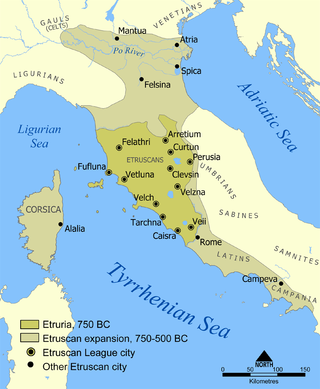
The Etruscan civilization was an ancient civilization created by the Etruscans, a people who inhabited Etruria in ancient Italy, with a common language and culture who formed a federation of city-states. After conquering adjacent lands, its territory covered, at its greatest extent, roughly what is now Tuscany, western Umbria, and northern Lazio, as well as what are now the Po Valley, Emilia-Romagna, south-eastern Lombardy, southern Veneto, and western Campania.
The Old Italic scripts are a family of ancient writing systems used in the Italian Peninsula between about 700 and 100 BC, for various languages spoken in that time and place. The most notable member is the Etruscan alphabet, which was the immediate ancestor of the Latin alphabet used by more than 100 languages today, including English. The runic alphabets used in Northern Europe are believed to have been separately derived from one of these alphabets by the 2nd century AD.
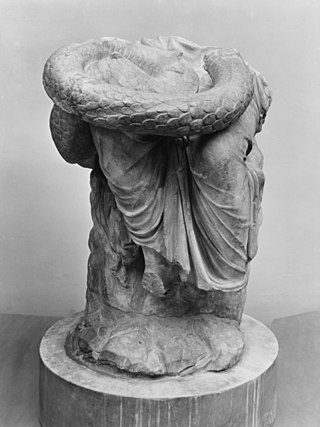
Hygieia is a goddess from Greek mythology. Hygieia is a goddess of health, cleanliness and hygiene. Her name is the source for the word "hygiene".
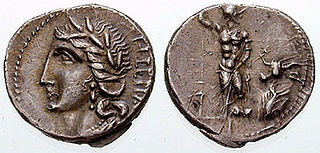
Oscan is an extinct Indo-European language of southern Italy. The language is in the Osco-Umbrian or Sabellic branch of the Italic languages. Oscan is therefore a close relative of Umbrian and South Picene.

Old Latin, also known as Early, Archaic or Priscan Latin, was the Latin language in the period roughly before 75 BC, i.e. before the age of Classical Latin. It descends from a common Proto-Italic language; Latino-Faliscan is likely a separate branch from Osco-Umbrian with possible further relation to other Italic languages and to Celtic; e.g. the Italo-Celtic hypothesis.
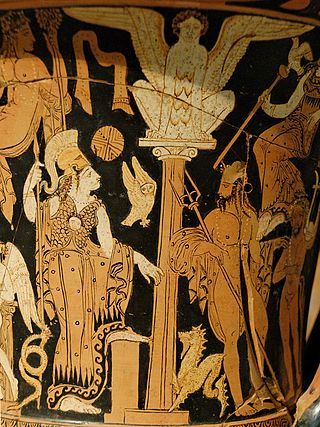
The Faliscan language is the extinct Italic language of the ancient Falisci, who lived in Southern Etruria at Tiber Valley. Together with Latin, it formed the Latino-Faliscan languages group of the Italic languages. It seems probable that the language persisted, being gradually permeated with Latin, until at least 150 BC.

The Praeneste fibula is a golden fibula or brooch, today housed in the Pigorini National Museum of Prehistory and Ethnography in Rome. The fibula bears an inscription in Old Latin, claiming craftsmanship by one Manios and ownership by one Numazios. At the time of its discovery in the late nineteenth century, it was accepted as the earliest known specimen of the Latin language. The authenticity of the inscription has since been disputed, repeatedly rejected and affirmed, with one assertion of antiquity dating to the first half of the seventh century BC.

The Duenos inscription is one of the earliest known Old Latin texts, variously dated from the 7th to the 5th century BC. It is inscribed on the sides of a kernos, in this case a trio of small globular vases adjoined by three clay struts. It was found by Heinrich Dressel in 1880 in the valley between Quirinale and Viminale in Rome. The kernos is part of the collection of the Staatliche Museen in Berlin.

The Lapis Satricanus, is a yellow stone found in the ruins of the ancient town of Satricum, near Borgo Montello, a village of southern Lazio, dated late 6th to early 5th centuries BC. It was found in 1977 during excavations by C.M. Stibbe.

The Etruscan alphabet was used by the Etruscans, an ancient civilization of central and northern Italy, to write their language, from about 700 BC to sometime around 100 AD.

The Osco-Umbrian, Sabellic or Sabellian languages are an extinct group of Italic languages, the Indo-European languages that were spoken in Central and Southern Italy by the Osco-Umbrians before being replaced by Latin, as the power of Ancient Rome expanded. Their written attestations developed from the middle of the 1st millennium BC to the early centuries of the 1st millennium AD. The languages are known almost exclusively from inscriptions, principally of Oscan and Umbrian, but there are also some Osco-Umbrian loanwords in Latin. Besides the two major branches of Oscan and Umbrian, South Picene may represent a third branch of Sabellic. The whole linguistic Sabellic area, however, might be considered a dialect continuum. Paucity of evidence from most of the "minor dialects" contributes to the difficulty of making these determinations.

The Latino-Faliscan or Latinian languages form a group of the Italic languages within the Indo-European family. They were spoken by the Latino-Faliscan people of Italy who lived there from the early 1st millennium BCE.
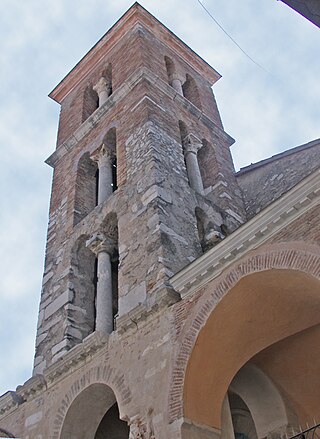
Minturno is a city and comune in southern Lazio, Italy, situated on the north west bank of the Garigliano.

Sessa Aurunca is a town and comune in the province of Caserta, Campania, southern Italy. It is located on the south west slope of the extinct volcano of Roccamonfina, 40 kilometres (25 mi) by rail west north west of Caserta and 30 kilometres (19 mi) east of Formia.

Latium Adjectum or Adiectum or Latium Novum was a region of Roman Italy between Monte Circeo and the river Garigliano, south of and immediately adjacent to Old Latium and included with it under the Roman Empire.

Satricum, an ancient town of Latium vetus, lay on the right bank of the Astura river some 60 kilometres (37 mi) SE of Rome in a low-lying region south of the Alban Hills, at the NW border of the Pontine Marshes. It was directly accessible from Rome via a road running roughly parallel to the Via Appia.
The Tita Vendia vase is a ceramic impasto pithos. The pithos, which exists only as an incomplete set of sherds, carries one of two earliest known inscriptions in Latin language and is usually, but not unanimously, interpreted as the earliest instance of a bipartite female Latin name with praenomen and gentilicum.

Gaius Antius Restio was a politician of the Roman Republic. He is principally known for the lex Antia sumptuaria, a law against luxury he passed as tribune of the plebs in 68 BC. This law forbade magistrates from attending banquets, in an attempt to contain political corruption. One of the few sources on Restio's life is a poem of his contemporary Catullus, telling that he was an enemy of Publius Sestius, a politician and good friend of Cicero.
References
- 1 2 Cf. page 200, BALDI (2002)
- ↑ Vine, Brent (1998). "Remarks on the Archaic Latin "Garigliano Bowl" Inscription" (PDF). Zeitschrift für Papyrologie und Epigraphik . 121: 257–262. Archived from the original (PDF) on 31 March 2012. Retrieved 13 August 2014.